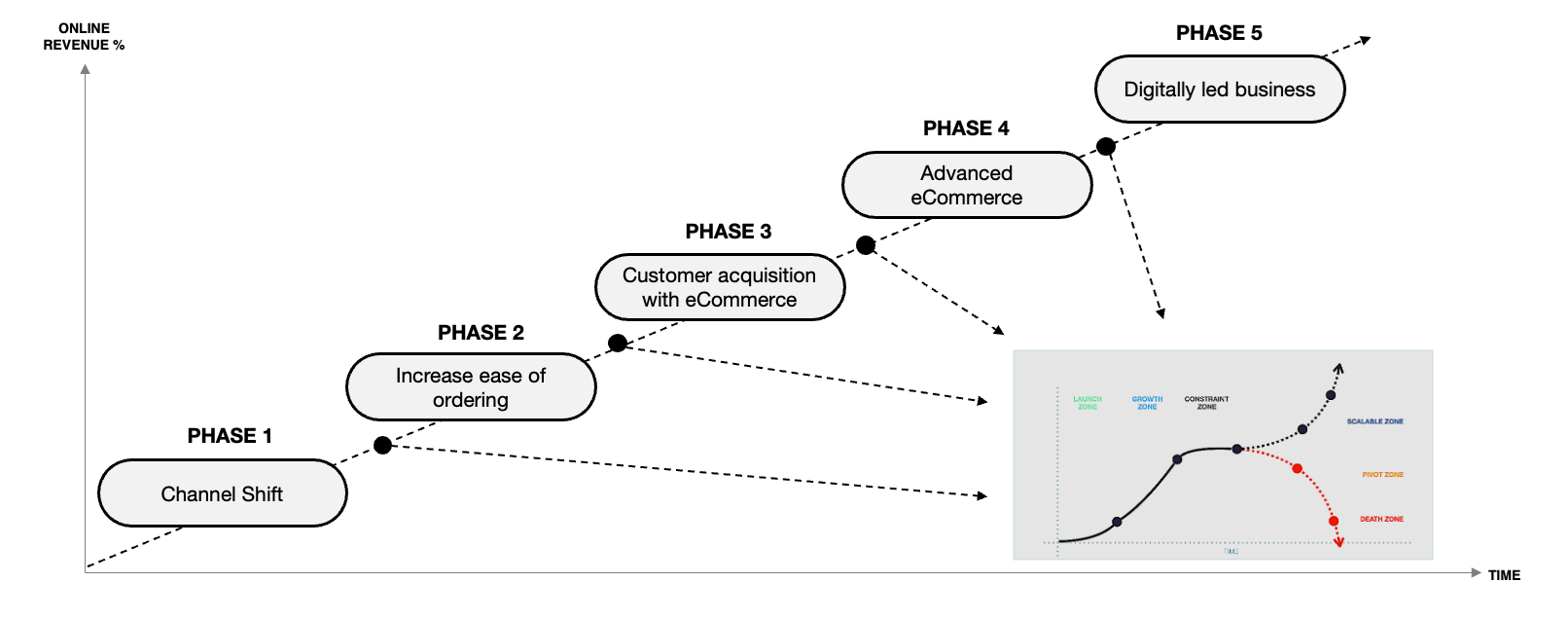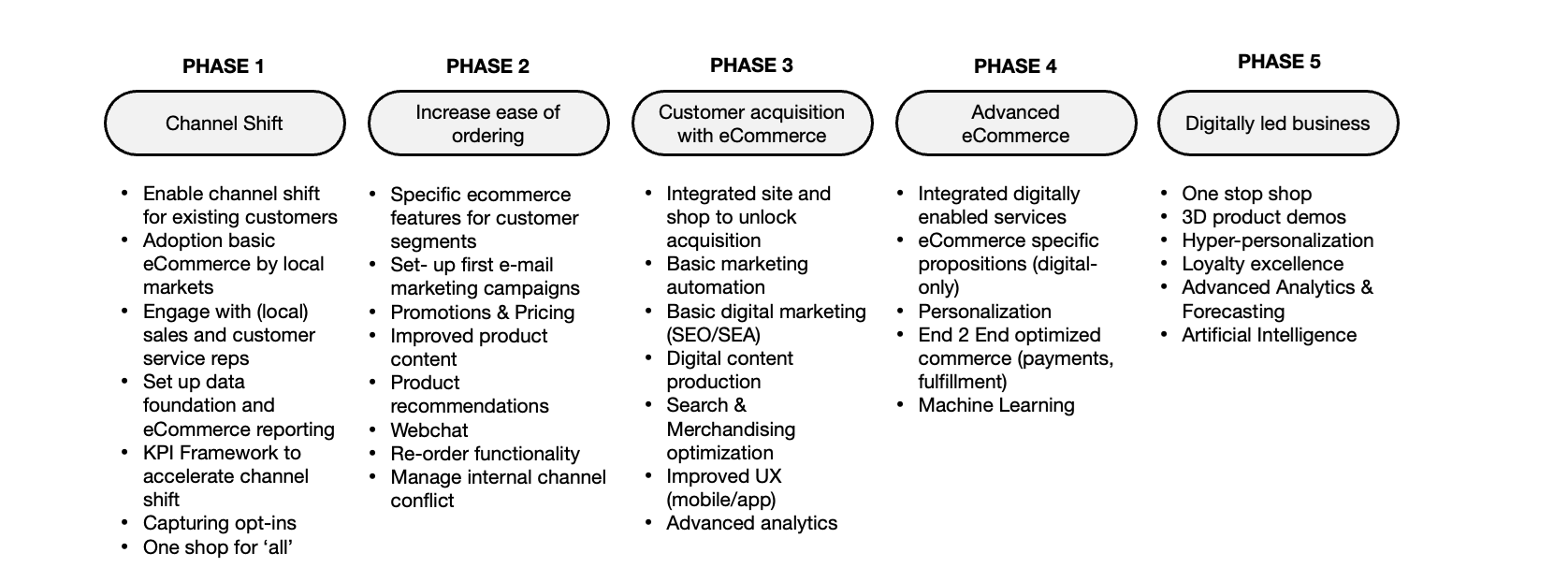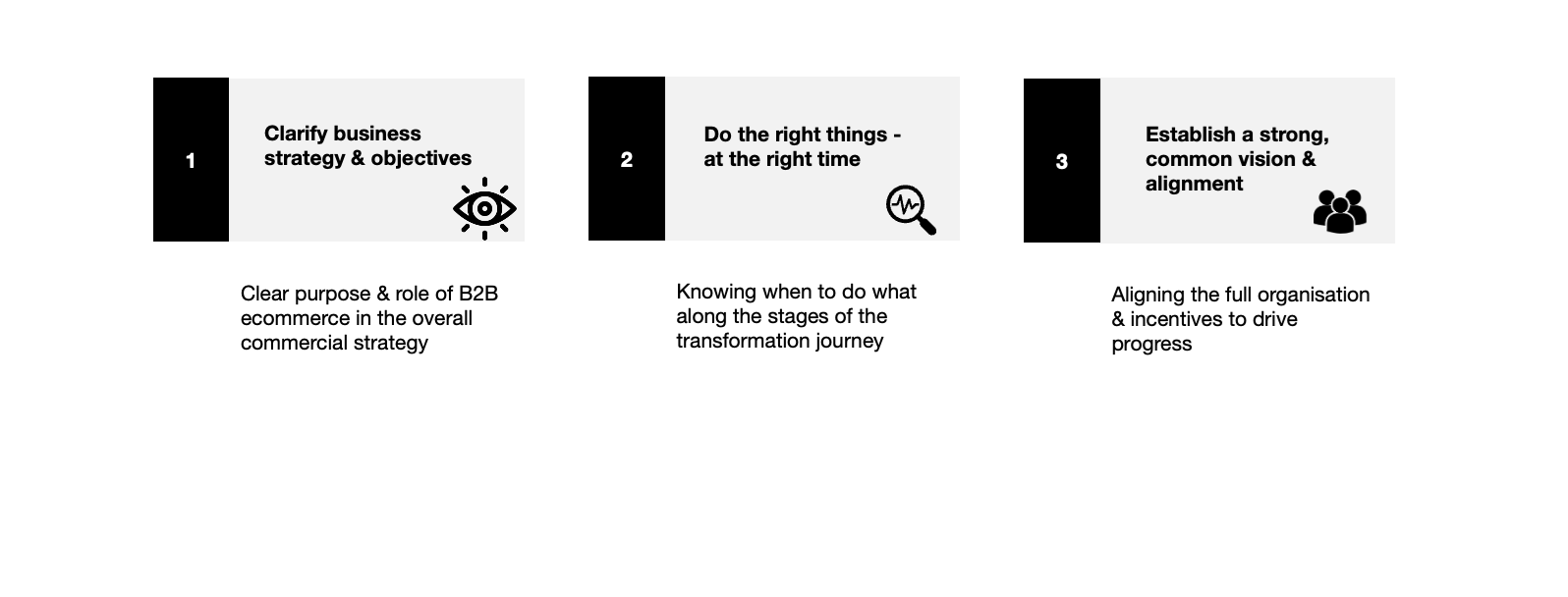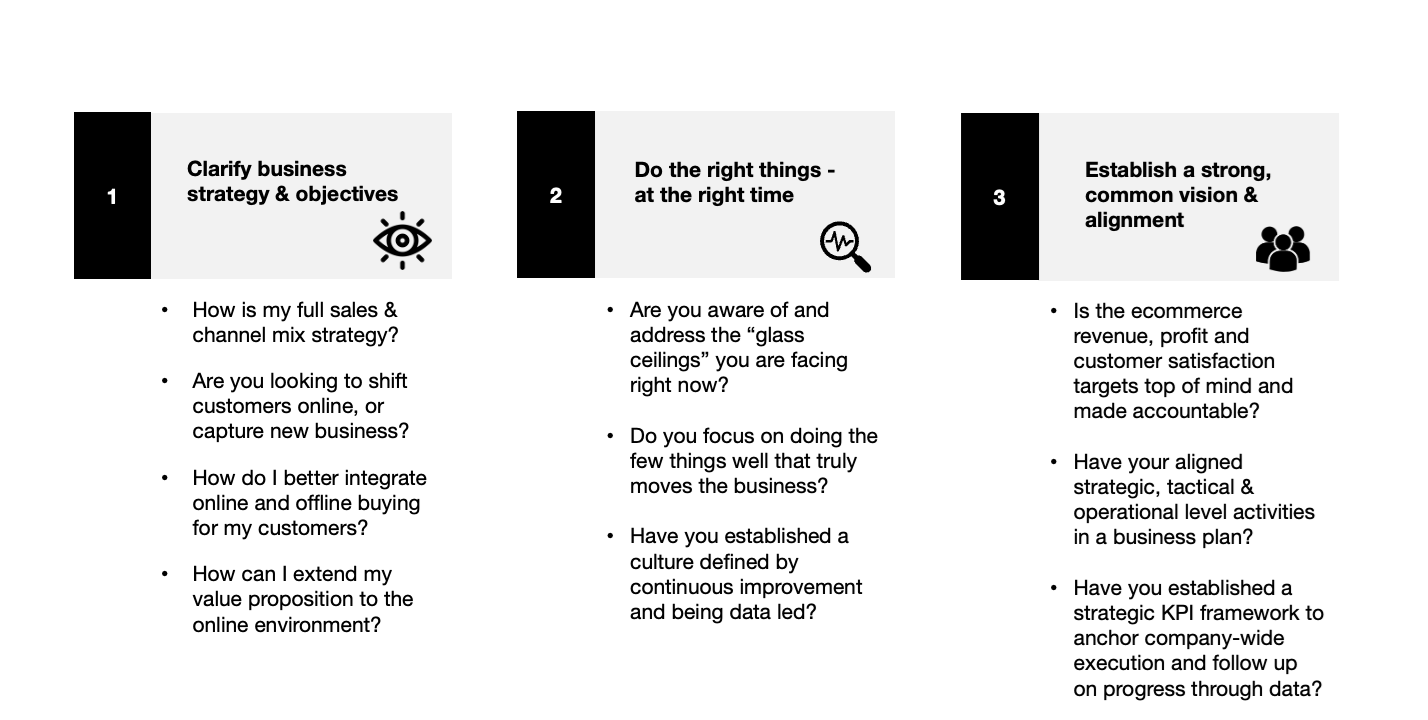March 30, 2023
The opportunity in business-to-business ecommerce is evident. Ecommerce is a growing area of business for most B2B manufacturers as customers increasingly adopt the online channel and expect an omnichannel offering. However, many companies don’t feel they have a good B2B ecommerce or e-business strategy. They are typically faced with too vague strategic objectives, lacking an operationalized direction, difficulties getting the desired traction or struggling with internal alignment. The risk is that B2B companies—despite putting in significant efforts—fly blind without direction and miss out on a significant business opportunity as competitors enter the online space.
The good news though is, when done right, B2B ecommerce can and should help deliver on some of the most prominent objectives in any business: growing revenue, improving profitability and making customers happy.
In this article, we look at the challenges and opportunities of B2B ecommerce. Based on our experience, we share how successful B2B ecommerce transformations can be affected to pave out more successfully.
The “Glass Ceilings” of B2B Ecommerce Growth
At Valtech, we generally see B2B manufacturers faced with different “glass ceilings” along their B2B ecommerce journey.
We see five phases of the commerce journey each with their glass ceiling to overcome when moving from one phase to another (see illustration below). Looking at the five phases and the characteristics of each, it is not only possible to detect the current stage of your own B2B commerce business, but also the steps after that first step needing to be addressed.
Phases & Glass Ceilings of the B2B Ecommerce growth journey

* Nb. All companies different not necessarily fitting perfectly in exactly one phase – above is a generalization)
To over-simplify and do the classical test of selecting one thing that should be your guiding star along the journey - the easiest way to reach commercial impact is to focus persistently on driving adoption across the organization by migrating customers from more expensive touch points to online. As customers are already buying from you directly, you can use those touchpoints to encourage channel shift. Successes and learnings can be used to further improve channel shift and then down the road launch marketing activities to acquire new customers for your ecommerce proposition.
However, it is unfortunately not that simple. ecommerce is not a project, but establishing a new business with new (end-to-end) processes and capabilities that has a transformational impact across many parts of the organization (see also our whitepaper The Voice of Digital Leaders in Manufacturing 2023).
But what if growth falls flat despite having the best intentions; have you reached a glass ceiling because of your fully utilized potential or have you not executed with the right focus?
The point of illustrating the above 5 phases (see illustration) is that we know how important it is to focus on the right things to deliver the desired outcome for your business. We typically see two traits across B2B businesses here. As a business, you either get stuck and limited by the glass ceilings going too slowly from one phase to another, ending up in a “dead zone,” or you end up executing on topics from all five phases at the same time, spreading your efforts too thin. In both situations, you don’t execute your ecommerce business efficiently.
The Phases of B2B Ecommerce

By adding clear stages with clear priorities in your strategic direction for your ecommerce journey you will benefit from learning mistakes from other B2B manufactures that started earlier and struggled to break the glass ceilings.
But how to change and work with this then?
Breaking the Glass Ceilings To Create Momentum
Every B2B business carries obvious differences from the distribution/sales channel mix, to industry specifics/logics and even the complexity and number of products. However, having worked with multiple B2B businesses to set up and scale their B2B operations, they also have a lot in common.
Some areas stand out when looking at why some companies have successfully executed and broken through the glass ceilings within B2B ecommerce. These are areas of attention that particularly need to be in focus and clarified with the highest possible precision:
- The strategic business role/purpose of B2B ecommerce operations
- The specific levers to unlock ecommerce growth
- The organizational alignment needed to succeed
Consequently, it is our experience that B2B ecommerce needs to be operated with a mindset that is based on a focus on three corresponding strategic accelerators (see below). Focusing and managing these three strategic accelerators is what has the highest impact on whether you will be able you to break through the glass ceilings along your journey.
Strategic Accelerators of B2B Ecommerce

Let’s take a look at each of these.
1. A clear strategy & a simple plan
Firstly, it’s obviously crucial to have a clear and detailed B2B ecommerce strategy. This requires that you ask and spend time answering some fundamental questions regarding your ecommerce operations that will define where and how you should prioritize your efforts.
First and foremost, you need to define what your business objectives are for B2B ecommerce. Are you looking to shift customers online or capture new business? Is it about efficiency, revenue growth, protection or something else entirely? Having done that, make sure that the objective is aligned all the way to top management.
As a consequence of this, your full sales channel mix strategy and the specific role of B2B ecommerce should be clear. It needs to be crystal clear where you want to play and how you will try to win.
When this is in place, you can then move even closer to where you should be starting or focusing your efforts in the strategic plan to be laid out. This includes fundamental answers to the questions: How do you want to better integrate online and offline buying for your customers? How can you extend your existing value proposition to the online environment?
By answering these questions and building the implications of the answers directly into your ecommerce strategy, you will be off to a great start. The issue here is that often these links and business implications are neglected and the B2B ecommerce business is “set in the water” to operate with unclear objectives and roles. This piece of the puzzle requires attention and really needs to be thought through. It is not enough to state that this “obviously fits in our overall strategy,” you need to be able to answer why, where and how B2B ecommerce plays a role.
In essence, if this clarity is not in place, you are creating friction before getting started—almost certainly leading to a lower return of investment than expected/possible.
2. Do the right things at the right time
“Doing the right things” can seem a provocative or obvious statement at best. However, it addresses a common issue faced by many B2B ecommerce businesses. Projects and efforts tend to get their own life and requests pour in from all over the organization throughout the process. This is an area to really keep an eye on, and this is where your clear strategic mission gets to be your best friend and reference point.
Your efforts should, and should always, be focused on the few things that move the needle towards your objective.
If you start with B2B ecommerce and your initial growth needs to come from channel shift, your key focus should be deeply understanding the customer triggers to start ordering online over other routes to market. All efforts should be focused on this and no other fancy shining things. To break glass ceilings in subsequent phases, your focus should shift to other KPIs and priorities.
Every phase has its own challenges and dynamics, but some activities are applicable for success at any stage:
- Have a vigorous focus on those day-to-day activities that really move the needle. Make sure you are able to track progress and your improvements really improve your main KPIs for that specific phase.
- Make sure you execute with a test, measure, learn mindset and prevent waiting till more complex features or initatives are ready to be implemented. Customer validation and feedback is key to ensure what you do will increase customer satisfaction.
- Keep in mind that success with B2B commerce should benefit not only digital teams but increase overall company success and results.
Not getting diluted by too many objectives also ties into the previous point of the article on the importance of strategic clarity. With a strong and focused strategy, you have a reference point. Without it, you risk getting diluted in your execution due to having too many targets or divergence on what is actually the right things to prioritize (because there is always a lot to do). Nailing this step on your ecommerce journey will create a platform for more efficient execution - an execution driven by doing the right things - not doing thing exactly right.
3. Establish a strong, common vision & alignment
The success of B2B ecommerce more than any other commerce endeavours leans on internal alignment.
Working in B2B ecommerce is a true team effort. It should not be driven by a few people in “digital” but by an entire business working towards the same objective of moving customers online or into the right omnichannel mix.
B2B commerce is an integral part of your overall distribution and sales strategy. A large part of future revenues is coming from existing offline sales and hence efforts need to be fully aligned and embedded in the sales organization. Same goes for marketing. Efforts here need to be aligned to new objectives from online and omnichannel being part of the sales mix. And finally, when it comes to the offering, whether being focused mostly on ordering, service portals etc., this is an effort needing to be created in close cooperation with the corporate IT department. You might have separate digital resources available for scaling B2B ecommerce but it sits within your existing infrastructure. Hence, alignment with this part of the organization is extremely important.
Then comes the incentive part. Everyone needs to have B2B as a priority. If this is only a secondary priority, the pace of evolution will most certainly be too slow.
It is crucial to set overall targets for B2B ecommerce—not just revenue numbers, but also in terms of profitability and customer satisfaction. This is what can really get an ecommerce business going. When you have this, you should then align the organization around a strategic KPI framework. Here you integrate the key activities to reach your overall targets and create a few performance indicators that you can measure to make sure that you are progressing towards the target and can adjust and discuss progress with everyone involved in the organization. Seems quite simple and it is, but it needs to be done, and many tend to skip this part leading to a lack of focus and progress.
Conclusion & Final Remarks
Now is the time to invest and execute efficiently because there is value to be unlocked in every B2B ecommerce business. The good news is that you can unlock this value with a focus on the three levers presented. By focusing on these and being aware of the growth phase you are in, you will be able to break through the glass ceilings that you will be faced with.
When working this way, you will see that you position yourself to handle the channel shift and strike the right offline/online balance for your customers, you will eventually gain incremental business and capture new business, and you ensure that you can compete or find a profitable co-existence with online sellers already pushing into the market or looking to do so.
We know things can get complicated when it comes to execution, but the point is: Make sure you are not making it complicated and un-focused. If you approach things this way, you will break the glass ceilings one by one. Happy journey!
Strategic Accelerators - Overview

About the Authors:
Carsten Pingel has been working within digital strategy and business development for the last 15 years. Carsten is leading the commercial strategy consulting unit within Valtech, helping companies in their digital transformation and utilizing data to accelerate growth. Former experience includes acquiring and scaling operations in multi-brand e-commerce businesses, enabling digital transformation in the largest Nordic media group and active board positions in high growth e-commerce and SAAS companies.
Bas Schreuder has been working in ecommerce for the last 20 years. As ex-bol.com employee experience includes accelerating growth in start-up and corporate environments, both in B2B and B2C. Before joining Valtech, Bas has been leading digital B2B activities of Jacobs Douwe Egberts – worlds leading pure play coffee company. As Director Commercial Strategy Bas is helping companies executing their ecommerce strategy with a data driven mindset.








